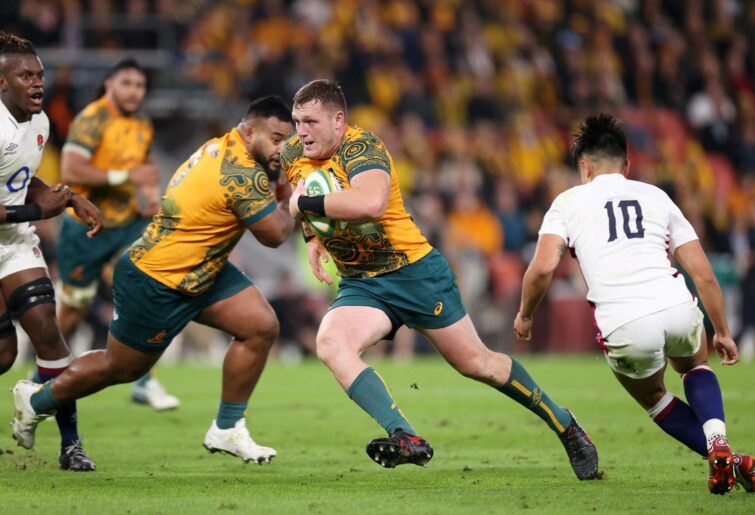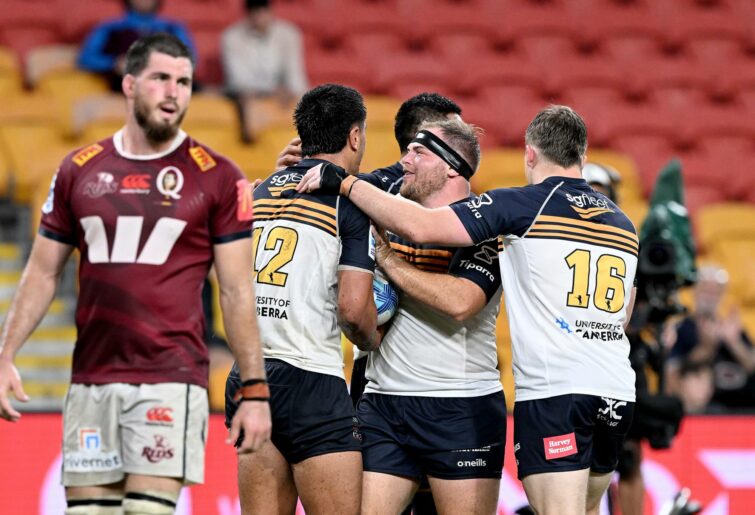Rugby fans young and old, weathered and wishful, rejoiced nation wide upon the announcement of the return of the Messiah.
Joseph Suaalii, a rugby prodigy at long last rescued from rugby league’s clutches of evil.
Yes, the Messiah, or at least, the latest one. That is, after Suliasi Vunivalu, Marika Koroibete, Israel Folau, and all of those that came before.
I wonder how the similarly eagerly anticipated young superstar Max Jorgensen feels about his $80K Waratahs contract, when upon inspection it appears to be a couple of digits short of his cohort mate Suaalii’s.
Particularly when the two will be directly competing for the same positions at the Waratahs very soon.
Put yourself in the shoes of an ambitious young rugby player in Australia and ask yourself why you’d actually sign a development contract with one of Australia’s five Super Rugby franchises to get the chance to play in front of dwindling crowds, in a competition with a receding national presence and image, if you had the opportunity to do the same in a bigger domestic competition – and all for a heavier pay cheque.
By signing Joseph Suaalii, Australian rugby have agreed to their greatest Faustian bargain to date.
They have green lighted and supported a new career path for their next generation of talent which involves arguably fast tracking their development by getting more minutes of top level footy in the NRL, a much longer competition, than they would have otherwise in a traditional rugby pathway.
In doing so, they inflate their contractual value, before returning to Australian rugby a few years later on their own terms and on greater money than they would have otherwise earned in the same time period had they just played union, with all the street cred that comes with going to war in the football competition more deeply rooted in Australian culture.

Joseph Suaalii. (Photo by Mark Kolbe/Getty Images)
Hell, the coach of the Wallabies has explicitly verbally endorsed the benefits of rugby league for a rugby union footballer and expressed his approval of players from a league background.
Do not forget that as our homo sapien ancestors once evolved from the apes, rugby union originally spawned from soccer, before league emerged as a modified version of union in Sydney.
It is helpful to understand fundamental differences in the Super Rugby competition as a sports and entertainment product in comparison to the NRL to empathise with the decisions faced by young footballers when the opportunity to become a professional athlete is presented to them.
The NRL exists as an annual tournament contested by clubs representing Aussie localities, some of whom have histories and roots which extend back over a century.
The league calendar is garnished with sprinklings of spectacle and novelty matches including State of Origin and some bespoke Test matches where the NRL players pull on a different coloured shirt, however the NRL competition remains the core offering of the sport in this market.
On the other hand, Super Rugby is essentially an extended trial for the Test sides of Australia and New Zealand, under the guise of a meaningful and free standing competition.
Unlike league, rugby’s test matches are its crown jewel, particularly in these nations, and other matches and competitions are incidental and secondary to it. Even big rugby fans contextualise domestic results against the backdrop of the World Cup, and the test matches leading up to it.
Looming All Blacks and Wallabies squad selections seem to hold more gravitas than Super Rugby fixture results.
This is part of the reason that NRL salary caps have more than doubled since 2012 from $4.4 million to $10 million in 2022, while in the same time period Australian Super Rugby salary caps have grown from $4.4 million to $5.5 million. You do the maths.
Until Australian rugby, and New Zealand with them, decide to bite the bullet and start more meaningful second tier competitions, Australian rugby will continue to start and end with the Wallabies for the majority of its casual fans, who go about their winters oblivious to the competition in which the average Aussie rugby player will play the majority of their footy.
Indeed, due to the surging tides of the global player market, Super Rugby’s prestige is a shadow of its former self compared to the glory days of the 90s and 2000s decades romanticised by many.
The AFL managed to grow a thriving nation wide competition and break out of its traditional Victorian market incrementally to now reap the rewards of its thoughtful long term strategic planning.
In Australia, rugby has historically had an almost identical challenge conquering new frontiers outside of its Sydney, regional NSW and Brisbane strongholds.
Similarly, the A-League, which began in the early 2000s, has managed to grow from an initial eight teams to now sit at 12, with more on the way.
Australian soccer parallels rugby in many respects, and arguably more than league, with it being a sport with a larger global presence than what is enjoyed in Australia, and with the biggest club competitions and salaries residing over in Europe.

Angus Bell of the Wallabies. (Photo by Mark Kolbe/Getty Images)
And until it finally accepts the fate of Super Rugby, Australian rugby will exist as a delicacy to be enjoyed in moderation; the sticky date pudding at the end of a rich smorgasbord of winter football in Australia, with gold jumpers pulled on once or twice a year.
Because despite the best efforts of the administration to neglect the foundational grass roots of the game for consecutive decades, rugby’s flickering flame will remain burning persistently while ever the global relevance of the game demands some foothold in Australia.
So given that the vast majority of the nation’s oval ball footballers, including those who may’ve previously played rugby growing up, plying their craft in the NRL, why shouldn’t the Wallabies select players from the NRL?
If these players actually want to represent Australia in rugby, and demonstrate the ability to be effective in certain positions, why shouldn’t the Wallabies pick these players?
With increasing professionalism and athleticism favouring power athletes in certain positions in particular, it’s not unreasonable that the much larger talent pool of league might simply have a greater statistical chance of providing the best winger or number eight than rugby.
And if rugby were to reframe the concept of “losing” its players to league, to instead the idea of using league’s resources to develop a portion of its own players temporarily, moral and virtuous reasons against the idea dissolve when faced with the logic of a business decision.
And for any rusted on fans aghast at the idea of NRL players being encouraged to float in and out of Australian rugby even quicker than before, perhaps ask yourself what might be in your son’s best interests if he were an up and coming young footballer in Australia.
Now, don’t get me wrong. As someone who has played and follows both codes, rugby is truly the game I find more interesting and exciting. I’d really love nothing more than for a meaningful Australian domestic competition, possibly converging with Trans Tasman and Pacific rivals for a Champions League style pinnacle, to come to fruition.

Tamati Tua of the Brumbies celebrates (Photo by Bradley Kanaris/Getty Images)
And I don’t for a second take for granted the tactical and skilful nuance of the 15-man game. I’m certainly not suggesting the superiority of either code, but am frankly taking a business perspective on the state of both games and challenging the status quo.
Let us not get caught up making subjective and qualitative comparisons between the ability of the footballers in the respective competitions.
Empires rise and fall, but organisations like states and businesses homogenise and grow together. New Zealand had a thriving ITM Cup before Super Rugby relegated the domestic competition to a second priority item.
Former Super Rugby participants South Africa have a solid third tier in their Currie Cup which form the backbone of the talent of their tier 2 franchises today, and throughout the Super era. They followed a slightly different path to Australia and New Zealand with their tier two teams leveraging existing Currie Cup stalwarts.
Did the creation of these shiny new Super Rugby teams , whose lustre seems to have worn off quicker than expected, come at the cost of the more organic local product?
While Rugby Australia toils away trying to make a square peg fit into a round hole, logistically, culturally and financially, with its Super Rugby Pacific, AU, XV and other variations over the years, has the knight in shining armour been the NRL all along?
A mere few generations ago, the two codes of union and league were simply two adjacent competitions in Sydney, before incremental rule changes in league led to it evolving into a different sport in modern times.
So really, depending on your definition of a professional footballer or rugby player, it appears that it may not necessarily be the case that Australian Rugby has a mere five domestic professional teams.
The way things are going these days, if we look a little closer, it’s getting less and less absurd to start counting the other 16 as football clubs contributing to the possible pool of Australian rugby players.
































































































